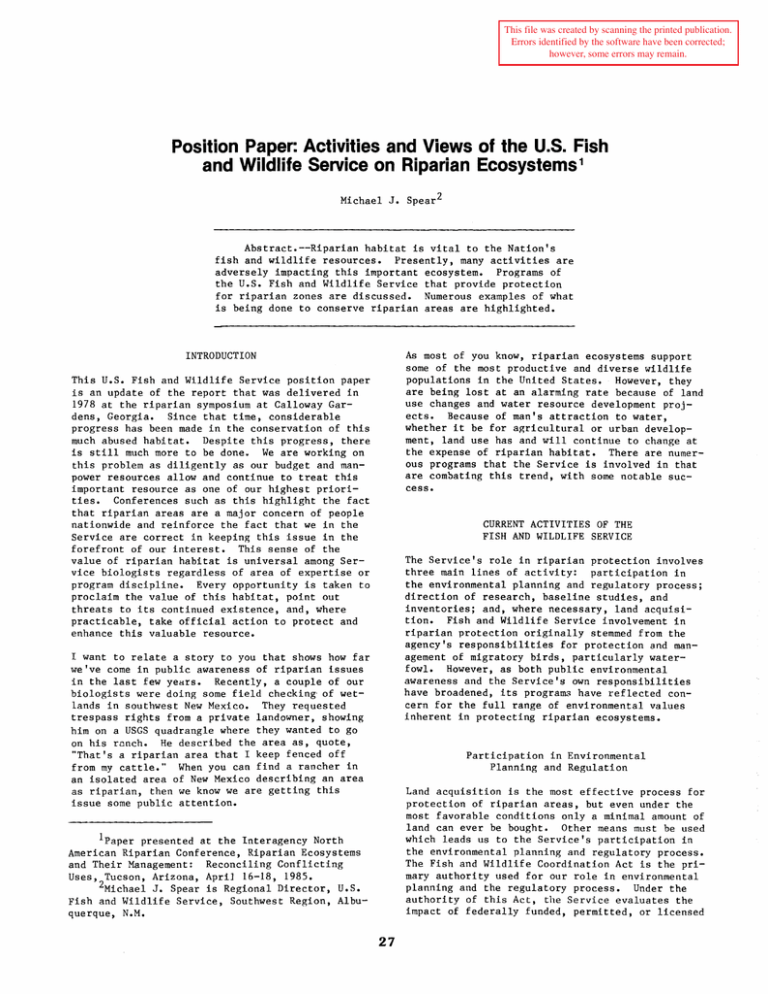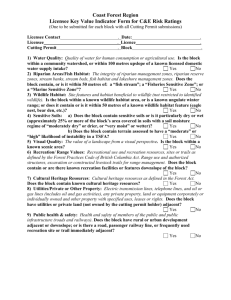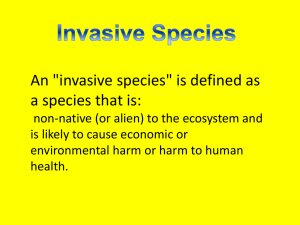Position Paper: Activities and Views ... and Wildlife Service on Riparian ...
advertisement

This file was created by scanning the printed publication. Errors identified by the software have been corrected; however, some errors may remain. Position Paper: Activities and Views of the U.S. Fish and Wildlife Service on Riparian Ecosystems 1 Michael J. Spear2 Abstract.--Riparian habitat is vital to the Nation's fish and wildlife resources. Presently, many activities are adversely impacting this important ecosystem. Programs of the u.s. Fish and Wildlife Service that provide protection for riparian zones are discussed. Numerous examples of what is being done to conserve riparian areas are highlighted. INTRODUCTION As most of you know, riparian ecosystems support some of the most productive and diverse wildlife populations in the United States. However, they are being lost at an alarming rate because of land use changes and water resource development projects. Because of man's attraction to water, whether it be for agricultural or urban development, land use has and will continue to change at the expense of riparian habitat. There are numerous programs that the Service is involved in that are combating this trend, with some notable success. This U.S. Fish and Wildlife Service position paper is an update of the report that was delivered in 1978 at the riparian symposium at Calloway Gardens, Georgia. Since that time, considerable progress has been made in the conservation of this much abused habitat. Despite this progress, there is still much more to be done. We are working on this problem as diligently as our budget and manpower resources allow and continue to treat this important resource as one of our highest priorities. Conferences such as this highlight the fact that riparian areas are a major concern of people nationwide and reinforce the fact that we in the Service are correct in keeping this issue in the forefront of our interest. This sense of the value of riparian habitat is universal among Service biologists regardless of area of expertise or program discipline. Every opportunity is taken to proclaim the value of this habitat, point out threats to its continued existence, and, where practicable, take official action to protect and enhance this valuable resource. CURRENT ACTIVITIES OF THE FISH AND WILDLIFE SERVICE The Service's role in riparian protection involves three main lines of activity: participation in the environmental planning and regulatory process; direction of research, baseline studies, and inventories; and, where necessary, land acquisition. Fish and Wildlife Service involvement in riparian protection originally stemmed from the agency's responsibilities for protection and management of migratory birds, particularly waterfowl. However, as both public environmental awareness and the Service's own responsibilities have broadened, its programs have reflected concern for the full range of environmental values inherent in protecting riparian ecosystems. I want to relate a story to you that shows how far we've come in public awareness of riparian issues in the last few years. Recently, a couple of our biologists were doing some field checking· of wetlands in southwest New Mexico. They requested trespass rights from a private landowner, showing him on a USGS quadrangle where they wanted to go on his rnnch. He described the area as, quote, "That's a riparian area that I keep fenced off from my cattle." When you can find a rancher in an isolated area of New Mexico describing an area as riparian, then we know we are getting this issue some public attention. Participation in Environmental Planning and Regulation Land acquisition is the most effective process for protection of riparian areas, but even under the most favorable conditions only a minimal amount of land can ever be bought. Other means must be used which leads us to the Service's participation in the environmental planning and regulatory process. The Fish and Wildlife Coordination Act is the primary authority used for our role in environmental planning and the regulatory process. Under the authority of this Act, the Service evaluates the impact of federally funded, permitted, or licensed 1Paper presented at the Interagency North American Riparian Conference, Riparian Ecosystems and Their Management: Reconciling Conflicting Uses, Tucson, Arizona, April 16-18, 1985. 2Michael J. Spear is Regional Director, U.S. Fish and Wildlife Service, Southwest Region, Albuquerque, N.M. 27 water resource development projects and recommends measures for the mitigation and/or enhancement of fish and wildlife resources in conjunction with proposed projects. This Act allows us to comment and advise on projects that run the gamut from large federally funded projects, such as dams, to small private projects, such as a pier. Even though we have no veto or enforcement power other than on Service-administered lands, our comments are usually taken seriously by the responsible federal agency and, through this medium, riparian areas sometimes can be conserved. wetlands and floodplains, whenever there is a practicable alternative. Research, Baseline Studies, and Inventories Our involvement in development of baseline (natural resource) information on riparian areas may be the most important contribution we make for the conservation of this habitat. I can almost hear you all thinking that what usually happens when we gather information on a riparian area is that we give a sum of money to someone to study the area and then the area is developed as if the study didn't exist. In other words, the study may have informed us that there were animals or resource values in a particular area, but we did not have the clout to influence project modifications. That is often the case, but let me give you an example of a study on a proposed U.S. Army Corps of Engineers project that did pay huge dividends. A number of' years ago, the Corps came to us and requested information on what impacts their proposed project would have on a riparian area in the Middle Rio Grande. Our Ecological Services Field Office in Albuquerque, New Mexico, performed a preliminary study and delivered a Fish and Wildlife Coordination Act report to the Corps in which it stated, among other things, that more resource information was needed in order to adequately evaluate the problems. The Corps reacted to this report in the most positive way possible. They devoted large resources to the questions we asked and eventually requested assistance from other agencies. A study group was then formed which involved the Service, the Bureau of Reclamation, New Mexico Department of Game and Fish, U.S. Army Corps of Engineers, and the Soil Conservation Service. This study group, after detailed analysis, decided what further data were needed, and more importantly, finally settled on a contractor who could deliver the answers. The contractor performed admirably and was able to deliver data that were used by managers to determine the impacts of the project. For instance, the contractor informed us that of 440 bird species in,New Mexico, 62 percent or 277 species were in the study area. The contractor also informed us specifically as to what parts of the riparian habitat were most valuable. The project was then planned and modified by the Corps so that impacts to fish and wildlife resources were substantially lessened. Major gains in such conservation have been achieved through coordinated planning as directed by the Fish and Wildlife Coordination Act for the Regulatory Storage Division of the Bureau of Reclamation's Central Arizona Project. Under the authority of that Act, and in concert with the State of Arizona, the Service developed several mitigation recommendations for approximately 42,000 acres of fish and wildlife habitat impacted by the proposed dam construction or modification on the Salt, Verde, and Agua Fria Rivers. Riparian habitat constituted only a small percentage of actual acres affected, but was recognized as the most valuable of habitats within the project area. As such, it received the highest priority in the planning process. Through the implementation of the Fish and Wildlife Service's Mitigation Policy, we designated areas of riparian habitat which could not be impacted in any way - their value to endangered species and overall ecosystem stability was found to be too high to allow any modification. Remaining riparian areas within the affected river basins were ranked only slightly lower in quality, but were still deemed crucial elements of the terrestrial and aquatic communities. Impacts to those areas required full and in-kind mitigation. For every unit value lost, an equal unit should be replaced. This level of complete mitigation was accepted by the Bureau of Reclamation and included in final project design. The Central Arizona Project represents only one example of protection of riparian resource values for fish and wildlife through coordinated planning. However, as planners and builders continue to look to the nation's riparian areas for development, continued efforts at accommodation where possible, but protection where necessary, will become major components of this planning. Using the Fish and Wildlife Coordination Act and the Service's Mitigation Policy, we can provide responsible biological bases upon which the values of riparian habitat may be incorporated into project design. In another area of pre-development planning, the Service has recently initiated two special projects, one involving bottomland hardwood habitat in Oklahoma, the other riparian habitat in Arizona. In Oklahoma, we are working in 28 counties in the eastern part of the State to determine the status of bottomland hardwood habitat. Based on our recently completed study, we determined that 85 percent of this habitat has been converted to other land use. This study greatly assisted us in raising a red flag on this important, dwindling resource. We are now seriously studying certain tracts of this habitat for acquisition. Additionally, because of what we found in eastern Oklahoma, we are beginning a second study to determine the status of riparian habitat in western Oklahoma. With the advent of the National Environmental Policy Act, the Service now has an advisory role in a wide array of projects that may not directly impact on water resources. For instance, we might comment on a Department of Housing and Urban Development Environmental Impact Statement and suggest ways to lessen secondary impacts of a project on riparian habitat. Our advice would carry certain weight because of the Executive Orders on Protection of Wetlands and Floodplain Management. These Orders direct federal agencies to avoid impacts, either direct or indirect, on 28 proximately 210 species of birds. Additionally, a study recorded 78 species of mammal~ in the grasslands corridor between the riparian woodlands and adjacent mountains. This represents the secondhighest mammalian diversity recorded in the world. Significantly, the San Pedro provides a critical link to many species that travel between Mexico and the United States. Unfortunately, this valley is being threatened by extensive clearing of the riparian areas for agricultural, residential, and recreational development. The State, with very active leadership from Governor Babbitt, is analyzing protection strategies for the San Pedro River. The Service is pleased to provide support information for Arizona's effort. In Arizona. our Ecological Services Field Office in Phoenix is initiating a cooperative study to inventory riparian habitat in the State. Presently, they are conducting inquiries among other agencies to determine the interest and effort that can be devoted to this important task. Hopefully, a cooperative effort can be conducted that will give us much needed baseline data that we can use for planning. Land Acquisition As we stated in our 1978 position paper, the Fish and Wildlife Service had at that time about 35 million acres in National Wildlife Refuges and Waterfowl Production areas. The Refuge system now consists of about 90 million acres. Most of the new acreage is in Alaska. Interestingly, in the lower forty-eight states a large number of acres that we have recently purchased have been targeted in riparian areas. For example, the Tensas River National Wildlife Refuge in Louisiana, which Is approximately 51,500 acres, is predominantly bottomland hardwood habitat. Panther Swamp National Wildlife Refuge, another recently purchased bottomland hardwood area located in Mississippi, encompasses approximately 20,000 acres. Additionally, the much publicized Atchafalaya River floodplain, which has become one of our most important national resource priorities, is slowly but surely being protected. The Service and the State of Louisiana presently control 50,000 acres with approximately another 10,000 acres proposed for purchase in the near future. THE FUTURE FOR RIPARIAN HABITAT Increased public awareness is critical to the conservation of our remaining habitat. We must keep public attention on this resource by taking every opportunity to speak out on the issues. This much abused habitat, especially in the West, demands our undivided attention. We must all keep in mind that in our democracy no action is usually taken until we have a concerned citizenry that demands action from its elected officials. A concerted effort by all of us is needed to keep this issue in the forefront of public awareness. Without this involvement, all the studies, symposia, and concern by resource agencies will be for naught. The whole issue of wetlands, which includes riparian habitat, is presently in the limelight and receiving considerable attention. It is incumbent upon all of us to guarante~ that this attention continues to prevail, thus insuring the preservation of riparian habitat for future generations to enjoy. Moving a little closer to home, our Southwest Region (Texas, Oklahoma, Arizona, New Mexico) has been very active in plans for acquisition or protection of bottomland hardwood areas in Texas and Oklahoma. We have identified a number of areas in these two states for protection and hopefully will be able to afford some sort of security to these ecosystems in the near future. "The last word in ignorance is the man who says of an animal or plant: 'what good is it?' If the land mechanism as a whole is good, then every part is good, whether we understand it or not. If the biota, in the course of aeons, has built something we like but do not understand, then who but a fool would discard seemingly useless parts? To keep every cog and wheel is the first precaution of intelligent tinkering." In southeastern Arizona, the San P~dro River and its adjoining riparian habitat have long been identified as being a nationally significant ecosystem. This river is the best remaining example of a major riparian ecosystem in the Southwest still largely unaffected by man. This nationally significant river and its adjoining vegetation provides nesting, migratory, or wintering habitat for at least 20 raptor species and a total of ap- Aldo Leopold--A Sand County Almanac 29








